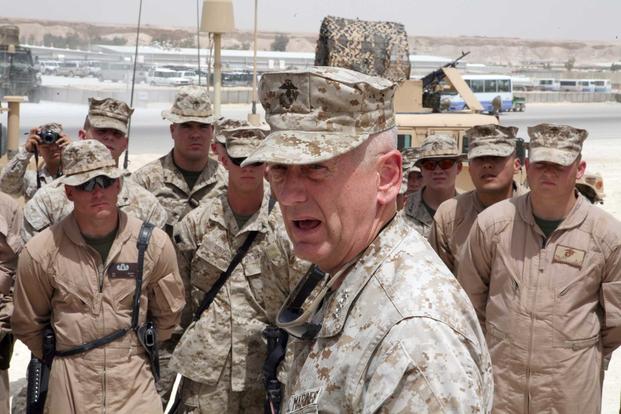Jim Mattis is gone after coming to loggerheads with the commander-in-chief, but his bottom-line legacy as defense secretary to boost "lethality" is driving a revolution in how the military conducts the most elemental form of combat on the small-unit level.
New gear and technology for squads and platoons is on the way -- the money and the commitment are there -- but the doctrine for employing them is still a work in progress.
The mission is the same as it always has been for the infantry: Close with and destroy the enemy in what commanders sometimes call the "short-sword warfight."
Under Mattis' directive, the military is developing new technologies and weapons for accomplishing the close-combat mission. But squad and platoon tactics haven't changed in a century, according to retired Marine Lt. Col. Joseph L'Etoile, head of the Pentagon's Close Combat Lethality Task Force (CCLTF).
As he described it in an interview with Military.com last week, the problem lies in meshing the capabilities being developed for troops on the front lines with a new concept of how best to use them.
"Today, we stand a chance of having capabilities in want of a concept," L'Etoile said. "We are producing, acquiring, eye-watering capabilities for the close-combat formations."
These range, he said, from squad-level unmanned aerial systems, to next-generation squad weapons and rifles, to the Integrated Visual Augmentation System (IVAS) for day-or-night rapid target acquisition.
"So you have these capabilities, new squad weapon, the list goes on and on," he said. "If we provide these advanced capabilities but we are still using legacy tactics, we're not going to fully extract from these capabilities what they're possible of delivering."
In October, L'Etoile said at an Association of the U.S. Army panel discussion that he had concerns about a possible shortfall down the line in research and development funding for CCLTF, but he stressed last week that adequate funding was included in the $3.6 billion over five years that the Pentagon currently plans to spend on lethality programs.
The task force doesn't have a specific budget, L'Etoile said, but instead leverages "multiple pots of money" in other programs and "as of today, every dollar of the money that was specifically identified to address the close-combat formations is on track."
Two Up, One Back, Straight Up the Middle
What L'Etoile called the "last renaissance" for squad tactics came with the "Sturmtruppen," or Stormtroopers, of the Imperial German Army during World War I.
To break out of the trench warfare stalemate, the Stormtroopers sought to achieve tactical surprise by using fire and maneuver to overwhelm weak points in the enemy line, bypassing strong points along the way.
Junior leaders were encouraged to use their initiative as the attack developed. The strong points were to be left to following troops.
The Stormtrooper tactics took the German Army to the gates of Paris before faltering in 1918.
"Fundamentally, tactics have not changed at the squad level since then," L'Etoile said. Army and Marine Corps field manuals through the years, written in almost identical language, appear to bear him out.
On offense, the squad and platoon mission is "to decisively defeat, destroy, or neutralize the enemy force, or to seize key terrain." On defense, it is "to repel, to defeat, or to destroy an enemy attack and to gain the initiative for the offense."
In the execution of those missions, "the Infantry platoon and squad must be ready to adapt to various levels of conflict and peace in various environments," according to Army Directorate 3-21.8, published in 2016.
"This requires bold, aggressive, resourceful, and adaptive leaders -- leaders of character, competence and commitment -- who are willing to accept known risks to accomplish the mission. Infantry leaders must use their initiative," the publication states.
What all that translates to on the battlefield for the squad and platoon is the concept of "two up, one back" in the attack, meaning two units moving forward with one in reserve to exploit advantages.
And therein lies the rub for L'Etoile.
The new technologies and equipment, he said, won't be used to their fullest extent "if we still do two up, one back."
Mattis Pressed 'Lethality' Across the Board in All Services
In memos to the services and combatant commanders, and in the National Defense Strategy, Mattis, a retired Marine general, called for new initiatives to boost the lethality of the joint force to meet challenges posed by "peer competitors," meaning Russia and China.
In a July 2017 memo, he ordered the service vice chiefs to form a working group to "provide the Military Departments increased flexibility to organize, train and equip more ready and lethal forces." The Close Combat Lethality Task Force was one result.
The National Defense Strategy, overseen by Mattis, states, "Our aim is a Joint Force that possesses decisive advantages for any likely conflict while remaining proficient across the entire spectrum of conflict."
In a later memo last February, Mattis, a former infantry officer, focused on the task ahead for the CCLTF. He said that "personnel policies, advances in training methods, and equipment have not kept pace with changes in available technology, human factors, science, and talent management best practices" in terms of improving the lethality of the squad and platoon.
A spokesman for Acting Defense Secretary Patrick Shanahan told Military.com last week that improving lethality across the board will remain a top priority going forward.
The only change will be to "go faster on the implementation and the execution," Shanahan said at an informal session with Pentagon reporters Jan. 29.
In an earlier session with defense reporters, Shanahan said his focus on lethality is with "the person most downrange. It's all about how do we make them more lethal? How do we make their efforts easier? How do we make them smarter, faster, stronger, better?"
The U.S. military has already been learning lessons in the peer competitor challenge in Syria, where Russian troops are backing the regime of Syrian President Bashar al-Assad.
At a roundtable with defense reporters last week, members of Special Purpose Marine Air-Ground Task Force-Crisis Response-Central Command, who have operated in Syria, gave a glimpse of the problems posed to U.S. close-combat formations, Military.com reported.
Col. George Schreffler III, who commanded the task force from April to December, wouldn't go into detail for security reasons, but said U.S. infantry troops must be more attentive to camouflage and hiding their electronic footprints "when any adversary [can look] at you with their own small unmanned aerial systems or their aircraft."
"We have to continue to train to minimize our signatures, both from an electromagnetic perspective and from a physical visual and audible observation perspective," he said.
The lessons learned from all quarters are being absorbed by the CCLTF, said L'Etoile, who stressed that his mission will continue apace despite Mattis' abrupt exit over President Donald Trump's surprise order to withdraw U.S. troops from Syria.
"This is not a pipe dream," L'Etoile said of the CCLTF's work. "Has there been any sort of energy lost in Secretary Mattis' departure and Secretary Shanahan's arrival as the secretary? Absolutely not.
"Secretary Shanahan has made it explicit that the mission of the CCLTF continues," L'Etoile said. "There really has not been any perceptible decrease across the department in the essential work of the CCLTF."
He continued, "Secretary Shanahan was very, very explicit" in his internal discussions "to continue the mission, continue to push, continue to accelerate these efforts because he is 100 percent aware of the brutal calculus that drove us to this point."
Ninety percent of casualties are suffered by the infantry, which makes up only four percent of the total force.
"You know, especially going into a peer-competitor environment, we need to do something about that now," L'Etoile said.
-- Richard Sisk can be reached at Richard.Sisk@Military.com.














